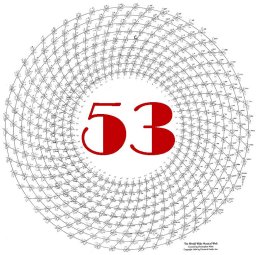Next Page: 11/10 – Microtonal Voicing
Commas in 53-eq
Once you get deeper into 53-eq tuning, you will discover that the small intervals between the 53 steps take you much closer to just-intonation pitches of all kinds. The 12-eq commas we discussed above are like gross puns. The commas that are yet to be discovered in 53-eq are like subtle layers of meaning in a Shakespeare play by comparison. There is one set of commas that are very effective in 53-eq and is even occasionally evoked in 12-eq: the septimal commas. There are several septimal commas we will talk about in Chapter 14, but for now, an example of a true 53-eq comma is that of the 225:224 septimal/”ga-ga” (seventh harmonic vs. the spine two just thirds up from your tonic). From C to its seventh harmonic is 969 cents. The nearest 53-eq note is A2#/B1b, which is 973.5 cents, or 4 ½ cents sharp. That’s not perfect but pretty good, compared to the 12-eq Bb which is 1000 cents, or 39 cents sharp of the seventh harmonic. The 225/128 ratio created between C and the pure just A2# (two fifths up and two just thirds up) is 977 cents, about eight cents higher than the pure harmonic seventh. So the 53-eq A2# is right in the middle: 969 (7th harmonic), 973.5 (53-eq A2#/B1b), 977 (pure A2#). This means you can start with a septimal seventh going in and then change its harmonic usage to the ga-ga A2# going out for some extremely effective chord progressions. But, I tip my hand. In Chapter 14 I promise to make you a septimal magician with hundreds of new possible chord progressions exploiting this and other septimal commas. But this general principle applies to all commas in all tuning systems: to use commas to create harmonic ambiguity, you can always enter a note and give it a context where it has one harmonic meaning, and then leave that same pitch while giving it an entirely different harmonic meaning based on what follows.
If you would like to learn more about this chapter, “Commas in 53-eq,” and much more (with 500 53-eq commas not available in 12-eq tunings), you can buy the entire book, The Grand Unified Theory of Music, in pdf form for $25 with hundreds of embedded musical examples of scales and chords from all over the world.
A free introduction to what The Grand Unified Theory of Music offers is on this website and includes both text and a few musical examples from each webpage. If you would like to learn more about this chapter and the full contents of this entire e-book, you can buy The Grand Unified Theory of Music for $25, with hundreds of embedded musical examples of scales and chords from all over the world — and ideas for how to set up your computer system —
HERE.
You’ll get a personalized password you can use to see the entire e-book. Inside the full book, you will also get a link to the complete pdf file of this e-book, which you can read on your Kindle or similar device. The links to the hundreds of mp3 sound files – the same ones you can hear on the website — will also be included. This is “Version 1.0” of The Grand Unified Theory of Music. Because it is an e-book, additions, corrections and improvements in the sound may be added at any time. The Grand Unified Theory of Music is Copyright © 2018 by Christopher Mohr. All rights reserved.
One person per password. Sharing this password with others is a violation of copyright. Do not allow others to use your password or link to the pdf file!
